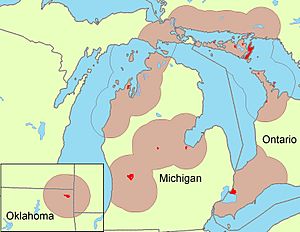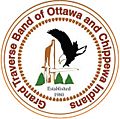Odawa facts for kids

Odawa group areas.
|
|
| Total population | |
|---|---|
| 15,000 | |
| Regions with significant populations | |
| United States (Oklahoma, Michigan) Canada (Ontario) |
|
| Languages | |
| English, French, Ojibwe (Ottawa dialect) | |
| Religion | |
| Midewiwin, Animism, traditional religion, Christianity, other | |
| Related ethnic groups | |
| Ojibwe, Potawatomi, and other Algonquian peoples |
The Odawa people, also known as Ottawa or Odaawaa, are an Indigenous American group. Their name means "traders". They mostly live in areas of the northern United States and southern Canada.
The Odawa have lived in lands that cross the modern border between these two countries for a long time. In the United States, they are officially recognized as Native American tribes. In Canada, they are recognized as First Nations bands. The Odawa are part of a larger group called the Anishinaabeg. They are related to, but distinct from, the Ojibwe and Potawatomi peoples.
Contents
Who are the Odawa?
The Odawa are one of the many Indigenous groups of North America. They have a rich history and culture. Their traditional lands are around the Great Lakes region. This area includes parts of what is now Michigan, Ohio, and Ontario.
Where Do the Odawa Live?
Today, many Odawa people live in their traditional territories. These are mostly in the US states of Michigan and Oklahoma. In Canada, they live in the province of Ontario. There are about 15,000 Odawa people today. They are part of different communities and nations.
A Look at Odawa History
The Odawa people have lived in the Great Lakes region for thousands of years. They were known as skilled traders. They traveled widely to exchange goods with other Indigenous groups. They traded things like corn, tobacco, and furs. This is how they got their name, "traders."
In the 1600s, European explorers and settlers arrived. The Odawa formed alliances with some European powers. They often worked with the French. This was especially true during the French and Indian War. They played an important role in the fur trade.
Important Leaders
One of the most famous Odawa leaders was Chief Pontiac. He was a powerful war chief. In 1763, he led a large uprising. This was known as Pontiac's War or Pontiac's Rebellion. He united many different Indigenous nations. They fought against British control after the French and Indian War. Pontiac wanted to stop the British from taking more land. He also wanted to protect Indigenous ways of life.
Odawa Culture and Traditions
The Odawa people have strong cultural traditions. Their spiritual beliefs often include Animism. This means they believe that spirits live in nature. They also follow the Midewiwin religion. This is a traditional spiritual society. It teaches about healing and a good way of life.
The Odawa language is a dialect of the Ojibwe language. It is part of the Algonquian languages family. Many Odawa people speak English or French today. But efforts are being made to keep the Odawa language alive.
The Odawa Today
Today, Odawa communities continue to thrive. They work to preserve their culture and language. Many Odawa people are involved in their tribal governments. They manage their own affairs. This includes education, health, and economic development. They also celebrate their heritage through ceremonies and events. These events help pass traditions to younger generations.
Images for kids
-
Mid-18th century sketch of an Odawa family by British soldier George Townshend.
-
Odawa warrior with gunstock war club.
-
Flag of the Little River Band of Odawa Indians.
-
Flag of the Little Traverse Bay Bands of Odawa Indians.
-
Flag of the Ottawa Tribe of Oklahoma.
-
Odawa Chief Pontiac speaking at a council on April 27, 1763, 19th-century engraving.
See also
 In Spanish: Ottawa (tribu) para niños
In Spanish: Ottawa (tribu) para niños








